 W
WThe Moro conflict, is an insurgency in the Mindanao region of the Philippines which has been ongoing since 1969, though non-Jihadist insurgency ended in 2019.
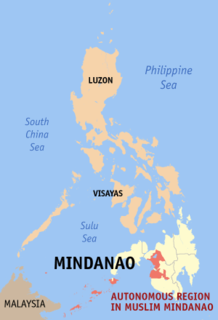 W
WThe 2000 Philippine campaign against the Moro Islamic Liberation Front was a military campaign conducted by the Armed Forces of the Philippines (AFP) against a Muslim secessionist group that took place during the presidency of Joseph Estrada in the Autonomous Region in Muslim Mindanao in the Philippines. The campaign was waged "to weaken the Moro Islamic Liberation Front's capability to undermine the territorial integrity of the Philippines and inflict harm on both government personnel and civilians".
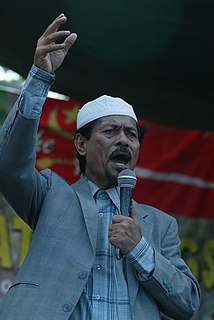 W
WThe 2001 rebellion of the Moro National Liberation Front Misuari faction against the Philippine government during the presidency of Gloria Macapagal Arroyo was led by Nur Misuari, the founder of the Moro National Liberation Front (MNLF). It began on November 19, 2001 when members of a faction of the MNLF loyal to Misuari attacked a Philippine Army headquarters in Jolo, Sulu in the Philippines. The attack was meant to disrupt the Autonomous Region in Muslim Mindanao elections scheduled for November 26 of that year, which eventually replaced Misuari as governor.
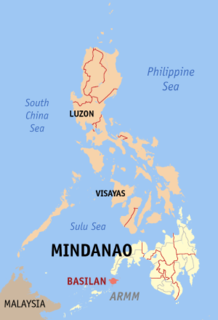 W
WBattle of Basilan was a military offensive launched by the Philippine military to apprehend two lead commanders in the Abu Sayyaf Islamic militia wanted for corruption, money laundering, and terrorism related charges. The main cause of the operation was Sayyaf leader Indama and his followers threatening and attempting to extort money from a circumferential road network. The two-day offensive ended with the both suspects evading capture and the island of Basilan falling under government authority. Both the army and MNLF collaborated in fighting alongside for a duration of the operation the first such instance since a truce. However collaborators within the Sayyaf militia included members of the MNLF who sympathized with their cause or had public relations with some of the militants.
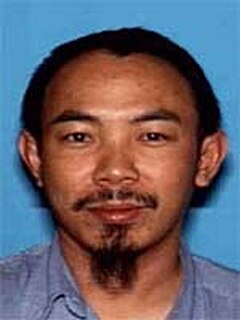 W
WZulkifli Abdhir was a Malaysian who was one of the FBI Most Wanted Terrorists. The American Federal Bureau of Investigation (FBI) agency offered a US$5 million reward for information leading to his capture. He was the maker of bombs delivered for usage to several terrorist groups. He was often referred to by the nom de guerre Marwan. He was suspected of leading the Kumpulan Mujahidin Malaysia (KMM), being part of the central command of the Jemaah Islamiyah (JI), and of involvement in the 2002 Bali bombings. He was suspected of hiding in Mindanao under the protection of the Bangsamoro Islamic Freedom Fighters. Zulkifli was killed on 25 January 2015 by Special Action Force (SAF) officers during the raid that culminated in the Mamasapano clash.
 W
WAbu Sayyaf, officially known by ISIL as the Islamic State – East Asia Province, is a Jihadist militant and pirate group that follows the Wahhabi doctrine of Sunni Islam. It is based in and around Jolo and Basilan islands in the southwestern part of the Philippines, where for more than four decades, Moro groups have been engaged in an insurgency seeking to make the province independent. The group is considered violent and was responsible for the Philippines' worst terrorist attack, the bombing of Superferry 14 in 2004, which killed 116 people. The name of the group is derived from the Arabic abu, and sayyaf ("swordsmith"). As of 2012, the group was estimated to have between 200 and 400 members, down from 1,250 in 2000. They use mostly improvised explosive devices, mortars and automatic rifles.
 W
WThe Bangsamoro are a majority-Muslim ethnic group occupying a range of territories across the southern portions of the Republic of the Philippines. On three occasions, a short-lived and unrecognized Bangsamoro state independent of the Philippines has been formally declared by the Moro National Liberation Front (MNLF). The first declaration was issued in 1974, amid the Moro conflict. Bangsamoro Land would be declared in 2012. In 2013, the United Federated States of Bangsamoro Republik was declared.
 W
WThe 2007 Basilan beheading incident was an armed incident in July 2007 between the Moro Islamic Liberation Front (MILF) rebels and the Philippine Army which led to the execution of 14 or 23 members of the Philippine Marines, amongst them 11 beheaded in the province of Basilan in the southern Philippines.
 W
WThe Battle of Camp Abubakar, codenamed Operation Terminal Velocity, was the final phase of the 2000 Philippine campaign against the Moro Islamic Liberation Front which resulted in the capture of Camp Abubakar al Siddique, stronghold of the Moro Islamic Liberation Front and its largest settlement, and seat of its Shariah-based government.
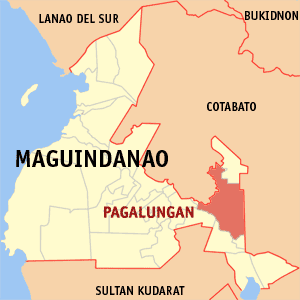 W
WThe Battle of the Buliok Complex took place on 11 February 2003 in an area within the provinces of Maguindanao and Cotabato in Mindanao, Philippines. The 60-hectare complex, which stretches from Pikit, Cotabato to Pagalungan, Maguindanao, was a stronghold of the Muslim separatist Moro Islamic Liberation Front (MILF). Accused by the Philippine government of harboring members of Pentagon, a notorious kidnap-for-ransom gang operating in Mindanao, the MILF was attacked in the Buliok complex by the Armed Forces of the Philippines under orders from then-President Gloria Macapagal Arroyo.
 W
WThe Battle of Tipo-Tipo was a military engagement that began on 9 April 2016 at Tipo-Tipo, Basilan Island, Philippines between forces of the Philippine Army and members of the Abu Sayyaf militant group. The battle resulted in dozens of casualties, with at least 18 soldiers and 31 militants reported killed, and more than 70 others injured. It was the largest single loss of life for the Philippine Army since the beginning of the year, and came just a day after the group had released an Italian hostage.
 W
WThe 2017 Bohol clashes were armed conflicts that took place in April and May 2017 between Philippine security forces and Moro ISIL-affiliated militants led by members of the Abu Sayyaf in Inabanga, Bohol, Philippines. Three Philippine Army soldiers, a policeman, four terrorists and two civilians were killed during the initial firefight. Subsequent firefights between the remaining militants and security forces resulted in the deaths of all the Abu Sayyaf insurgents. A ranking officer of the Philippine National Police linked to Abu Sayyaf attempted to rescue some of the insurgents but was arrested.
 W
WThe Dos Palmas kidnappings was a hostage crisis in the southern Philippines that began with the seizing of twenty hostages from the affluent Dos Palmas Resort on a private island in the Honda Bay, Palawan, by members of Abu Sayyaf on May 27, 2001 and resulted in the deaths of at least five of the original hostages, including two American citizens, Guillermo Sobero and Martin Burnham. At least 22 Filipino soldiers were killed in attempts to apprehend the captors and free the hostages in the 12 months following the initial hostage taking. An unknown number of captors were killed by government forces.
 W
WIsnilon Totoni Hapilon, also known by the nom de guerre Abu Abdullah al-Filipini, was a Moro Islamist militant affiliated with ISIS.
 W
WAbdullah Maute was a Moro militant who co-founded, along with his brother Omar Maute, a Dawlah Islamiyah group in Mindanao, Philippines commonly known as the Maute group after their surname.
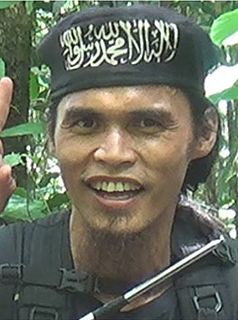 W
WOmarkhayam Romato Maute was a Moro terrorist who co-founded, along with his brother Abdullah Maute, a Dawlah Islamiyah group in Mindanao, Philippines, commonly known as the Maute group after their surname.
 W
WThe Mindanao bombings was a series of seemingly unrelated bomb attacks that took place on July 4, 5, and 7, 2009 in the towns of Datu Piang and Jolo, and the cities of Cotabato and Iligan in Mindanao, Philippines. The bombings killed around 7 people and injured at least 66. The Armed Forces of the Philippines has blamed several militant organizations active in Mindanao, such as the Moro Islamic Liberation Front (MILF), the Abu Sayyaf, and Jemaah Islamiyah.
 W
WThe Moro Islamic Liberation Front is a group based in Mindanao, Philippines seeking an autonomous region of the Moro people from the central government. The group has a presence in the Bangsamoro region of Mindanao, the Sulu Archipelago, Palawan, Basilan, and other neighbouring islands.
 W
WThe Office of the Presidential Adviser on the Peace Process is a government agency which handles peace talks and negotiations related to internal conflict and rebellion in the Philippines most notably the CPP-NPA-NDF and Moro conflicts.
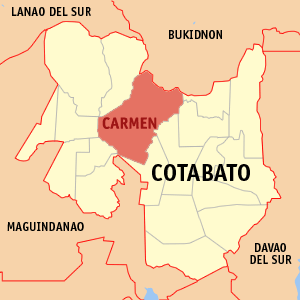 W
WOperation Audacity was a military operation during the 2000 Philippine campaign against the Moro Islamic Liberation Front which took place in Cotabato, Philippines. The Philippine Army, primarily units of its 6th Infantry Division, assaulted and cleared Moro Islamic Liberation Front forces from the Carmen-Banisilan area of Cotabato.
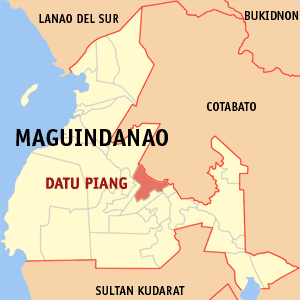 W
WOperation Valiancy was the initial military operation of the 2000 Philippine campaign against the Moro Islamic Liberation Front which took place in Maguindanao, Philippines. The Philippine Army, primarily units of its 6th Infantry Division, assaulted Moro Islamic Liberation Front forces in the Talayan-Shariff Aguak-Datu Piang area of Maguindanao and captured Camp Omar ibn al-Khattab, its third largest camp located there. Camp Omar, named after Umar, a senior Sahabi of the Islamic prophet Muhammad, served as the headquarters of the 206th BIAF brigade under Ameril Umbra Kato and was defended by 500 guerillas. Camp Jabal Uhob, another MILF camp in the area, was also captured. Planned to be a week-long operation, Valiancy took only two days to realize its objectives.
 W
WThe Pata Island massacre refers to an event that took place on February 12, 1981 in Pata Island, Sulu province in the Philippines. More than 100 Philippine Army officers and men were killed by Moro natives in what was called by retired Major General Delfin Castro as "the biggest number of casualties incurred by the Armed Forces of the Philippines in a single incident since the start of the conflict in Mindanao and had the dubious distinction of achieving the biggest losses in AFP firearms and equipment in a single incident."
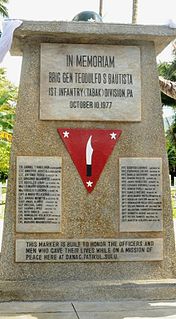 W
WThe Patikul massacre refers to an event that took place on October 10, 1977 in Patikul, Sulu province in the Philippines. Thirty-five officers and men of the Philippine Army were killed by elements of the Moro National Liberation Front under Usman Sali. Among the dead were Brigadier General Teodulfo Bautista, commanding general of the 1st Infantry Division, Adjutant General of the Armed Forces of the Philippines, Col. Gabriel Pangilinan and four lieutenant colonels.
 W
WProclamation No. 55 was signed by Philippine President Rodrigo Duterte on September 4, 2016, to officially declare a state of emergency in the Philippines in response to the 2016 Davao City bombing.
 W
WProclamation No. 216 was the 2017 proclamation of martial law and suspension of the privilege of the writ of habeas corpus in the whole of Mindanao, issued by Philippine President Rodrigo Duterte on May 23, 2017.
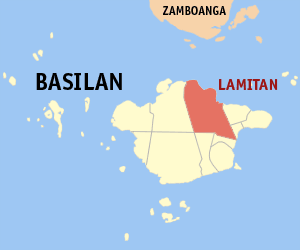 W
WThe Siege of Lamitan took place on 2 June 2001 when members of the Islamic terrorist group Abu Sayyaf entered the city of Lamitan, one of two Christian settlements in the predominantly Muslim province of Basilan in the Philippines. They took over a church and a hospital and held priests, medical staff and patients hostage. Government forces surrounded the Muslim extremists, preventing their escape. However, the Abu Sayyaf group managed to break out of the cordon by using their hostages as human shields.
 W
WThe 2000 Sipadan kidnappings was a hostage crisis in Sabah, Malaysia, and the southern Philippines that began with the seizing of twenty-one hostages from the dive resort island of Sipadan at approximately 6:15 p.m. on 23 April 2000, by up to six Abu Sayyaf (ASG) bandits. Taken hostage were 10 tourists from Europe and the Middle East and 11 Malaysian resort workers, 19 non-Filipino nationals in total. The hostages were taken to an Abu Sayyaf base in Jolo, Sulu.
 W
WThe 2004 SuperFerry 14 bombing on February 27, 2004, was a terrorist attack that resulted in the sinking of the ferry SuperFerry 14 and the deaths of 116 people in the Philippines' deadliest terrorist attack. Six children less than five years old, and nine children between six and 16 years of age were among the dead or missing, including six students on a championship team sent by schools in northern Mindanao to compete in a journalism contest.
 W
WThe Zamboanga City crisis or Zamboanga Siege was an armed conflict in Zamboanga City, Philippines between the forces of the Philippine government and a faction of the Moro National Liberation Front, generally known by other factions as the Rogue MNLF Elements (RME) under the Sulu State Revolutionary Command (SSRC) led by Ustadz Habier Malik and Khaid Ajibon, whose group continues to recognize Nur Misuari as MNLF Chairman. The crisis erupted on September 9, 2013 when this MNLF faction attempted to raise the flag of the self-proclaimed Bangsamoro Republik at Zamboanga City Hall, which had earlier declared its independence on August 12, 2013 in Talipao, Sulu. This armed incursion, which has been variously described a "crisis", a "standoff", a "siege", and a "humanitarian crisis", was met by the Armed Forces of the Philippines (AFP) and the Philippine National Police (PNP), which sought to free the hostages and expel the MNLF from the city. The standoff degenerated into urban warfare, and brought parts of the city into a standstill for days.